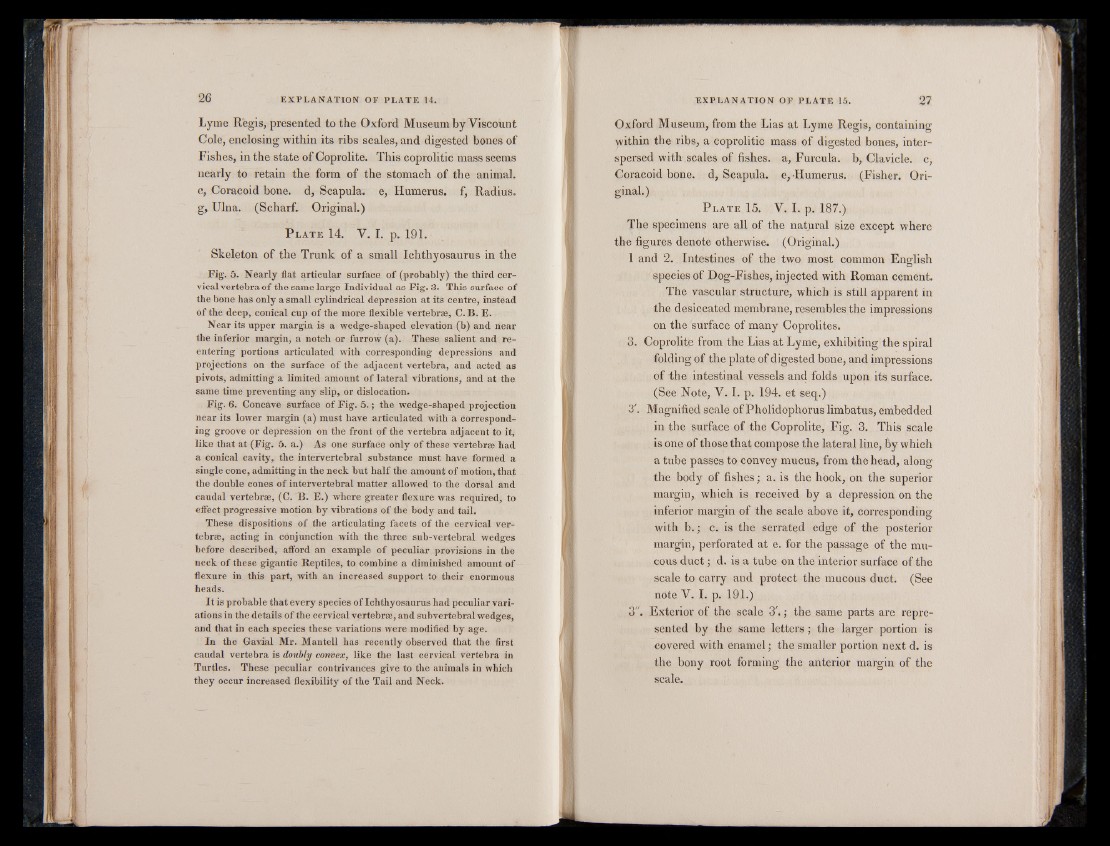
Lyme Regis, presented to the Oxford Museum by Viscount
Cole, enclosing within its ribs scales, and digested bones of
Fishes, in the state of Coprolite. This coprolitic mass seems
nearly to retain the form of the stomach of the animal,
c, Coracoid bone, d, Scapula, e, Humerus, f, Radius,
g, Ulna. (Scharf. Original.)
P la t e 14. V. I. p. 191.
Skeleton of the Trunk of a small Ichthyosaurus in the
Fig. 5. Nearly flat articular surface of (probably) the third cervical
vertebra of the same large Individual as Fig. 3. This surface of
the bone has only a small cylindrical depression at its centre, instead
of the deep, conical cup of the more flexible vertebra, C.B. E.
Near its upper margin is a wedge-shaped elevation (b) and near
the inferior margin, a notch or furrow (a). These salient and reentering
portions articulated with corresponding depressions and
projections on the surface of the adjacent vertebra, and acted as
pivots, admitting a limited amount of lateral vibrations, and at the
same time preventing any slip, or dislocation.
Fig. 6. Concave surface of Fig. 5.; the wedge-shaped projection
near its lower margin (a) must have articulated with a corresponding
groove or depression on the front of the vertebra adjacent to it,
like that at (Fig. 5. a.) As one surface only of these vertebras had
a conical cavity, the intervertebral substance must have formed a
single cone, admitting in the neck but half the amount of motion, that
the double cones of intervertebral matter allowed to the dorsal and
caudal vertebrae, (C. B. E.) where greater flexure was required, to
effect progressive motion by vibrations of the body and tail.
These dispositions of the articulating facets of the cervical vertebrae,
acting in conjunction with the three sub-vertebral wedges
before described, afford an example of peculiar provisions in the
neck of these gigantic Reptiles, to combine a diminished amount of
flexure in this part, with an increased support to their enormous
heads.
It is probable that every species of Ichthyosaurus had peculiar variations
in the details of the cervical vertebras, and subvertebral wedges,
and that in each species these variations were modified hy age.
In the Gavial Mr. Mantell has recently observed that the first
caudal vertebra is doubly convex, like the last cervical vertebra in
Turtles. These peculiar contrivances give to the animals in which
they occur increased flexibility of the Tail and Neck.
Oxford Museum, from the Lias at Lyme Regis, containing
within the ribs, a coprolitic mass of digested bones, interspersed
with scales of fishes, a, Furcula. b, Clavicle, c,
Coracoid bone, d, Scapula, e, -Humerus. (Fisher. Original.)
P late 15. V. I. p. 187.)
The specimens are all of the natural size except where
the figures denote otherwise. (Original.)
1 and 2. Intestines of the two most common English
species of Dog-Fishes, injected with Roman cement.
The vascular structure, which is still apparent in
the desiccated membrane, resembles the impressions
on the surface of many Coprolites.
3. Coprolite from the Lias at Lyme, exhibiting the spiral
folding of the plate of digested bone, and impressions
of the intestinal vessels and folds upon its surface.
(See Note, V. I. p. 194. et seq.)
3'. Magnified scale of Pholidophorus limbatus, embedded
in the surface of the Coprolite, Fig. 3. This scale
is one of those that compose the lateral line, by which
a tube passes to convey mucus, from the head, along
the body of fishes; a. is the hook, on the superior
margin, which is received by a depression on the
inferior margin of the scale above it, corresponding
with b .; c. is the serrated edge of the posterior
margin, perforated at e. for the passage of the mucous
duct; d, is a tube on the interior surface of the
scale to carry and protect the mucous duct. (See
note V. I. p. 191.)
3". Exterior of the scale 3'.; the same parts are represented
by the same letters; the larger portion is
covered with enamel; the smaller portion next d. is
the bony root forming the anterior margin of the
scale.